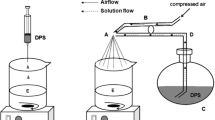Abstract
Purpose. A microparticle carrier based on alginate and poly-L-lysine was developed and evaluated for the delivery of antisense oligonucleotides at the intestinal site. Formulations of oligonucleotide-loaded microparticles having differences in the carrier molecular weight and composition were characterized in vitro and in vivo.
Methods. Polymeric microparticles were prepared by ionotropic gelation and crosslinking of alginate with calcium ions and poly-L-lysine. The loading of the antisense oligonucleotide into the microparticles was achieved by absorption in aqueous medium. The association capacity, loading and particle size of the microparticles were characterized. The in vivo performances of various formulations after intrajejunal administration were studied in rat and in dog models.
Results. Microparticles had a sponge-like structure and an oligonucleotide loading of 27-35%. The composition of the medium affected the particle size and the in vitro release profiles. The oligonucleotide bioavailability after intrajejunal administration to rats in the presence of permeation enhancers was good for most of the tested systems. The application of microparticles in powder form compared to an equivalent suspension improved the intrajejunal bioavailability of the oligonucleotide (25% and 10% respectively) in rats. On the contrary, the intrajejunal administration to dogs resulted in poor oligonucleotide bioavailability (0.42%).
Conclusions. The formulation of antisense oligonucleotides within alginate and poly-L-lysine microparticles is a promising strategy for the oral application.
Similar content being viewed by others
REFERENCES
P. D. Cook. Antisense medicinal chemistry. In S.T. Crooke (eds), Antisense Research and Application; Handbook of Experimental Pharmacology, Vol. 131, Springer-Verlag, Berlin, 1998, pp. 51–101.
R. M. Crooke. Cellular uptake, distribution and metabolism of phosphorothioate, phosphodiester, and methylphosphonate oligonucleotides. In S.T. Crooke and B. Lebleu (eds), Antisense Research and Applications, CRC Press, Florida, 1993, pp. 427–449.
G. Stix. Shutting down a gene. Antisense drug wins approval. Sci. Am. 279:46–50 (1998).
I. Lebedeva, L. Benimetskaya, C. A. Stein, and M. Vilenchik. Cellular delivery of antisense oligonucleotides. Eur. J. Pharm. Biopharm. 50:101–119 (2000).
R. S. Geary, J. M. Leeds, S. P. Henry, D. K. Monteith, and A. A. Levin. Antisense oligonucleotide inhibitors for the treatment of cancer: 1. Pharmacokinetic properties of phosphorothioate oligodeoxynucleotides. Anti-Cancer Drug Design 12:383–393 (1997).
P. L. Nicklin, S. J. Craig, and J. A. Phillips. Pharmacokinetic properties of phosphorothioates in animals, absorption, distribution, metabolism and elimination. In S.T. Crooke (ed). Antisense Research and Application; Handbook of Experimental Pharmacology, Vol. 131, Springer-Verlag, Berlin, 1998. pp. 141–168.
E. Wagner. Application of membrane-active peptides for nonviral gene delivery. Adv. Drug Deliv. Rev. 38:279–289 (1999).
S. Akhtar, M. D. Hughes, A. Khan, M. Bibby, M. Hussain, Q. Nawaz, J. Double, and P. Sayyed. The delivery of antisense therapeutics. Adv. Drug Deliv. Rev. 44:3–21 (2000).
F. Lim and A. M. Sun. Microencapsulated islets as bioartificial endocrine pancreas. Science 210:908–910 (1980).
R. P. Lanza, R. Jackson, A. Sullivan, J. Ringeling, C. McGrath, W. Kuhtreiber, and W. L. Chick. Xenotransplantation of cells using biodegradable microcapsules. Transplantation 67:1105–1111 (1999).
D. Lemoine, F. Wauters, S. Bouchendhomme, and V. Préat. Preparation and characterization of alginate microspheres containing a model antigen. Int. J. Pharm. 176:9–19 (1998).
T. L. Bowersock. H. HogenEsch, M. Suckow, P. Guimond, S. Martin, D. Borie, S. Torregrosa, H. Park and K. Park. Oral vaccination of animals with antigens encapsulated in alginate microspheres. Vaccine 17:1804–1811 (1999).
I. Aynie, C. Vauthier, H. Chacun, E. Fattal, and P. Couvreur. Spongelike alginate nanoparticles as a new potential system for the delivery of antisense oligonucleotides. Antisense Nucleic Acid Drug Dev. 9:301–312 (1999).
B. Thu, P. Bruheim, T. Espevik, O. Smidsrød, P. Soon-Shiong, and G. Skjåk-Bræk. Alginate polycation microcapsules: I. Interaction between alginate and polycation. Biomaterials 17:1031–1040 (1996).
H. E. Junginger. Mucoadhesive hydrogels. Pharm. Ind. 53:1056–1065 (1991).
W. R. Gombotz and S. F. Wee. Protein release from alginate matrices. Adv. Drug Deliv. Rev. 31:267–285 (1998).
A. V. Kabanov. Taking polycation gene delivery systems from in vitro to in vivo. PSTT 2:365–372 (1999).
S. C. De Smedt, J. Demeester, and W. E. Hennink. Cationic polymer based gene delivery systems. Pharm. Res. 17:113–126 (2000).
V. H. L. Lee, A. Yamamoto, and U. Bhaskar Kompella. Mucosal penetration enhancers for facilitation of peptide and protein drug absorption. Crit. Rev. Ther. Drug Carrier Syst. 8:91–192 (1991).
T. Lindmark, Y. Kimura, and P. Artursson. Absorption enhancement through intracellular regulation of tight junction permeability by medium chain fatty acids in Caco-2 cells. J. Pharmacol. Exp. Ther. 284:362–369 (1998).
L. A. Lapierre. The molecular structure of the tight junction. Adv. Drug Deliv. Rev. 41:255–264 (2000).
A. Fasano. Novel approaches for oral delivery of macromolecules. J. Pharm. Sci. 87:1351–1356 (1998).
D. J. Brayden. and D. J. O. Mahony. Novel oral drug delivery gateways for biotechnology products: polypeptides and vaccines. PSTT 1:291–299 (1998).
C. F. Bennett, J. E. Zuckerman, D. Kornbrust, H. Sasmor, J. M. Leeds, and S. T. Crooke. Pharmacokinetics in mice of a [3H]-labeled phosphorothioate oligonucleotide formulated in the presence and absence of a cationic lipid. J. Cont. Release 41:121–130 (1996).
M. Rajaonarivony, C. Vauthier, G. Couarraze, F. Puisieux, and P. Couvreur. Development of a new drug carrier made from alginate. J. Pharm. Sci. 82:912–917 (1993).
M. Butler, K. Stecker, and C. F. Bennett. Cellular distribution of phosphorothioate oligodeoxynucleotides in normal rodent tissues. Lab. Invest. 77:379–388 (1997).
M. Butler, K. Stecker, and C. F. Bennett. Histologic localization of phosphorothioate oligodeoxynucleotides in normal rodent tissue. Nucleosides & Nucleotides 16:1761–1764 (1997).
Author information
Authors and Affiliations
Corresponding author
Rights and permissions
About this article
Cite this article
Ferreiro, M.G., Tillman, L.G., Hardee, G. et al. Alginate/Poly-L-Lysine Microparticles for the Intestinal Delivery of Antisense Oligonucleotides. Pharm Res 19, 755–764 (2002). https://doi.org/10.1023/A:1016188312399
Issue Date:
DOI: https://doi.org/10.1023/A:1016188312399




